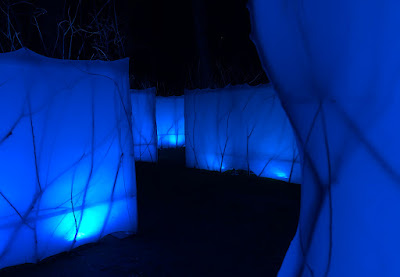Svetlobna gverila festival in Ljubljana, Slovenia is a gloriously spectacle-free light art festival. No additional wow effects added, no retinas harmed. I visited the 2022 edition and in my one year celebration series write about it now.
 |
| Marika Gönc's Night Fish was one of the lovely studies of shadows of the festival |
Small scale cosiness
The scale of the festival is best described as cosy. The artworks were quite small, compared to average light art festival. Few of them were high-tech, artisanship was more of a thing here. The artworks intertwined in the cityscape, some of them were even in a bit of a camouflage, which gave me an opportunity to do some urban sherlocking. Or maybe I’m just bad at reading maps.
Student works formed an exceptionally large part of the artworks, which I do appreciate. Generally, students are not marinated in the conventions of light art, which leads both to inventing the wheel again but more often to new angles and out of the box thinking. Which is easy, if you don’t know the box even exists. The student artworks, from a wide variety of academies and even high schools, were straightforward and confident in their exploration of light. Well done!
,%20Department%20for%20Industrial%20and%20Unique%20Design-%20T%20%E2%80%93%2060.jpg) |
| T – 60 by students of Academy of Fine Arts and Design played with slightly moving shadows and scale |
,%20Department%20for%20Video%20and%20New%20Media-%20In%20si%20tu%201.jpg) |
| The futuristic and mesmerising artwork in Academy of Fine Arts and Design's In Situ exhibition, by Lara Žagar, was one of the most promising student artworks in my list. |
Lack of Light Is a Fine Material
Shadows are in no way opposite of light as a material, but rather the black paint of light art. Already the Kinetic Art movement, a progenitor of light art, made a good use of shadows as well as reflections. Exhibit A: László Moholy-Nagy's Light Prop for an Electric Stage (Light-Space Modulator) from around 1930, which sometimes is referred as the first light art piece (debatable).
In many of the artworks, but especially in gallery ones, shadows were the rave material of this year’s festival. They were present as characters, illusions and visual elements, just to begin with.
My new favourite of shadow utilizers is Erik Mátrai. His two pieces in the festival, The Flag and Turul both were based on shadows giving another level of interpretation to what we see. In Turul, a surveillance camera’s shadows form wings and make it seem like a thing from a Gunnerkrigg Court strip, which is not mutually exclusive with the actual meaning of the word Turul, a mythical bird and a symbol of Hungarians.
In The Flag, we see a shadow of a flying flag, without the actual flag. Even though I was impressed by the simple expressiveness of the piece, I have to admit the idea is not too original: at least Simo Ripatti has ended up to a similar outcome in his Juhla (Occasion). Then again, great minds think alike.
 |
| Turul spreads its ominous wings |
 |
| The Flag flies ominously |
Neighborhood/(neigh)gorge(hood) by students of University of Ljubljana was exceptionally delightful, and not only because it could be observed from a really nice terrace of Art hotel (which might be my touristy tip, even if I didn't stay there), with a glass of sparkly. Quite fitting, indeed, since the artwork was about common urban spaces. There, the shadow of the art piece became even more important than the object itself.
Shadows Crawl Around Slovenia by Nikola Slavevski shows different kinds of shadow characters around Ljubljana. It was a kind of art collectible: single shadow might be nice, but spotting the lot of them is the real joy. I'm sure this was the favourite of Visit Ljublana staff, for making visitors ogle the city for reals.
-%20Neighborhood:(neigh)gorge(hood).jpg) |
| Shadows in the neighbourhood |
 |
| A shadow crawling around Ljubljana |
 |
| Shadows moving in City – Sketch by Andrej Štular & Janez Grošelj |
This is Not a Commercial Festival
The most striking specialty for me was the absence of spectacle. None of the artworks seemed to be planned purely oohs and aahs in mind. They were whatever the artist wanted them to be, with no apparent connection to visitor count. That, my friend, is pretty rare and daring, and the integrity of the festival deserves another toast of sparkling!
 | ||
| This Is Not a Commercial by Veli & Amos was probably the closest to a spectacle there was. And even that failed in being annoyingly showy. |























